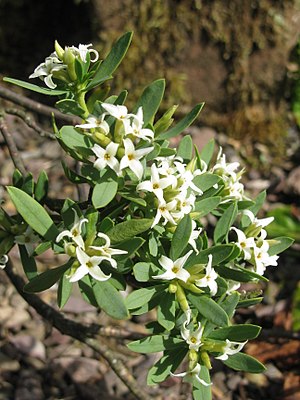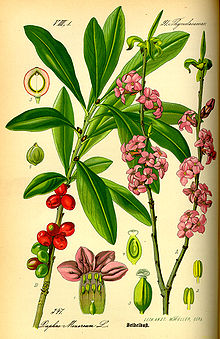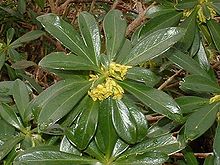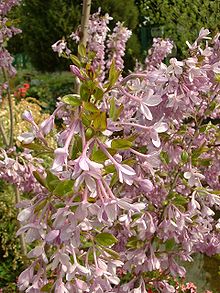daphne
| daphne | ||||||||||||
|---|---|---|---|---|---|---|---|---|---|---|---|---|

Daphne gnidioides |
||||||||||||
| Systematics | ||||||||||||
|
||||||||||||
| Scientific name | ||||||||||||
| Daphne | ||||||||||||
| L. |
The plant genus daphne ( Daphne ) belongs to the family of Thymelaeaceae (Thymelaeaceae). The genus includes about 70 to 92 species .
Daphne played a role in the early history of paper . Another folklore use is documented from Waldshut-Tiengen : carters put daphne, which was consecrated on the Assumption of Mary , on their hats so that witches could not ban the cart. Some species and varieties are rarely used as ornamental shrubs for near-natural gardens and parks.
description
Vegetative characteristics


The daphne species grow as deciduous or evergreen shrubs or semi-shrubs . The bark is hairy or glabrous. The mostly alternate, rarely opposite leaves are simple and short-stalked.
Inflorescences and flowers
The flowers are usually in final, rarely pendent, capitate, short racemose , paniculate or ährigen inflorescences together. At Daphne mezereum the flowers are califlowers . Some species are dioecious separately sexed ( diocesan ).
The hermaphroditic or unisexual flowers are four or five-fold. There is almost always a striking, free flower cup (hypanthium). The four or five sepals are cylindrical, bell-shaped to funnel-shaped fused with four or five upright or spreading calyx lobes, which are alternately larger and smaller. According to a second interpretation, there is no calyx tube, but the flower cup is tubular to bell-shaped and the sepals and stamens are inserted at its tip. This flower tube can be hairy or bald, depending on the species. The colors of the sepals range from white to cream to yellow and pink. There are no petals formed. There are two circles with four or five stamens each, which are free from each other. The either short or missing stamens do not protrude from the calyx tube. The more or less sessile, ovate, Upper permanent ovary is unilocular. The short style ends in a heady scar.
Fruits and seeds
The solitary fruits, which usually turn red or yellow when ripe, are interpreted as hard or dry and leathery berries or stone fruits ; they are sometimes covered with the chalice. The seeds contain little or no endosperm and an embryo with two fleshy cotyledons ( cotyledons ). The seed coat (testa) is crust-like.
Toxicity
Mainly in the cortex is Daphnetoxin and seeds Mezerein included. In humans, poison can also be absorbed through the skin. In addition to eating away at the skin, it also causes severe damage to the kidneys, the circulatory system and the central nervous system . A maximum of five berries produce only strong irritation. Eating ten berries can be fatal for children.
Some birds, such as thrushes , are apparently resistant to the poisonous pulp and spit out the stone kernels, thereby contributing to the spread.
Due to its toxic effect, the daphne was not of great importance in herbal medicine, with the exception of homeopathy . In England, the berries were used to treat diarrhea in horses.
Systematics and distribution










The daphne species are distributed across Eurasia . 52 species occur in China .
The generic name Daphne was first published in 1753 by Carl von Linné in Species Plantarum , 1, p. 356. Type species is Daphne laureola L. Synonyms for Daphne L. are Farreria I.B. Balfour & WWSmith ex Farrer , Pentathymelaea Lecomte and Scopolia L.
The botanical genus name Daphne is derived from the nymph Daphne . She was turned into a laurel tree by her father Peneios to protect her from her pursuer Apollo . The leaves of some daphne species are similar to those of the laurel tree, which is why the genus was named Daphne .
species
There are around 70 to 92 species of Daphne (selection):
- Daphne acutiloba Rehder : The species thrives in forests at altitudes between 1400 and 3000 meters in Hubei , Sichuan and Yunnan .
- Alpine daphne ( Daphne alpina L. ): It occurs in southern Europe , North Africa and Asia Minor .
- Altai daphne ( Daphne altaica Pall. ): It occurs in Xinjiang , in northwestern Mongolia and Siberia .
- Daphne angustiloba Rehder : This species thrives in mountain forests at altitudes between 3000 and 5000 meters in southwestern and western Sichuan and in Myanmar .
- Sapling daphne ( Daphne arbuscula Čelak. ); this species occurs only in central Slovakia on limestone cliffs at altitudes between 900 and 1300 meters
- Daphne arisanensis Hayata : This species thrives in forests only in Taiwan .
- Daphne aurantiaca Diels : It thrives in forests and on limestone cliffs at altitudes between 2,600 and 3,500 meters in southwestern Sichuan and northwestern Yunnan.
- Daphne axillaris (Merrill & Chun) Chun & CFWei : This species thrives in dense forests at altitudes between 600 and 900 meters in Hainan .
- Daphne bholua Buch.-Ham. ex D.Don : It occurs with two subspecies in Xizang and in northwestern Yunnan, in Bangladesh , Bhutan , India , Myanmar and Nepal .
- Royal Daphne ( Daphne blagayana Freyer ): It is native to the Balkan Peninsula .
- Daphne brevituba H.F.Zhou ex CYChang : This endemic thrives in open forests, bushy slopes and on rocks at altitudes of about 2000 meters in central and northwestern Yunnan (Heqing, Yimen).
- Caucasian daphne ( Daphne caucasica Pall. ): It is native to the Caucasus and Asia Minor.
- Daphne championii Bentham : This species thrives in forests at altitudes between 200 and 700 meters in Fujian , Guangdong , Guangxi , Guizhou , Hunan , Jiangsu and Jiangxi .
- Daphne chingshuishaniana S.S.Ying : This endemic thrives on shrubby slopes near the mountain peaks at altitudes of about 2200 meters only in eastern Taiwan (Hualian).
- Rosemary Daphne ( Daphne cneorum L. ): It occurs in Central Europe , in northwestern Spain , Italy and Eastern Europe .
- Daphne depauperata H.F. Zhou ex CYChang : This species thrives in dense forests at altitudes between 2000 and 3200 meters in western Yunnan.
- Daphne emeiensis C.Y.Chang : This endemic thrives in forests and on the edge of the forest at altitudes between 800 and 1100 meters in Sichuan (Emei Shan, Pingshan).
- Daphne erosiloba C.Y.Chang : This species thrives on sunny slopes at altitudes between 3200 and 3800 meters in western Sichuan.
- Daphne esquirolii H.Léveillé : This species thrives in valleys and on slopes at altitudes between 700 and 2000 (rarely up to 3400) meters in southwestern Sichuan and northeastern Yunnan.
- Daphne feddei H.Léveillé : This species thrives in forests and shrubby slopes at altitudes between 1,800 and 2,600 meters in Guizhou, Sichuan and Yunnan.
- Daphne gemmata E. Pritzel : This species thrives at altitudes between 400 and 1500 (rarely up to 1800) meters in north-western and western Sichuan and northern Yunnan.
- Daphne genkwa sieve. & Zucc. : The wide distribution area is in China, Taiwan and Korea .
- Daphne giraldii Nitsche : This species thrives on the edges of forests and open shrubby slopes at altitudes between 1,600 and 3,100 meters in Gansu , Heilongjiang , Liaoning , Qinghai , Shanxi , Sichuan and Xinjiang.
- Daphne glomerata Lam. : The range includes northeastern Turkey and the Caucasus.
- Daphne gnidioides Jaub. & Spach : It is common in the northeastern Mediterranean .
- Autumn daphne ( Daphne gnidium L. ): It occurs in the Canary Islands, in North Africa, Southern Europe and Asia Minor.
- Daphne gracilis E. Pritzel ; the species occurs in China (Chongqing) at altitudes between 1000 and 1300 meters
- Daphne grueningiana H.Winkler ; the species occurs in China (Anhui, Zhejiang) at altitudes between 300 and 400 meters
- Daphne hekouensis H.W.Li & YMShui : This species, which was only described in 2008, is endemic to Hekou in Yunnan at an altitude of about 690 meters
- Daphne holosericea (Diels) Hamaya ; the species occurs in China (Sichuan, SE Xizang, W Yunnan) at altitudes between 3000 and 3600 meters
- Daphne involucrata Wall. ; the species occurs in Bhutan and India
- Jasmine-like daphne ( Daphne jasminea Sm. ): It is native to Greece.
- Northern Japanese daphne ( Daphne jezoensis Maxim ., Syn .: Daphne kamtschatica var. Jezoensis (Maxim.) Ohwi ): It occurs on the Kuriles , Sakhalin and the Japanese northern islands
- Daphne jinyunensis C.Y.Chang ; the species occurs in China (Chongqing)
- Daphne jinzhaiensis D.C. Zhang & JZShao ; the species occurs in China (Anhui)
- Daphne Kamchatica Maxim. : The species occurs in East Asia (Russia, Korea)
- Daphne kiusiana Miq. : The species is native to Japan.
- Daphne laciniata Lecomte ; the species occurs in China (Yunnan) in forests at altitudes between 1000 and 1500 meters
-
Laurel daphne ( Daphne laureola L. ): The range includes North Africa, the Mediterranean, Western Europe and the Azores . With the subspecies:
- Daphne laureola L. subsp. laureola
- Daphne laureola subsp. philippii (Gren. & Godr.) Rouy (Syn .: Daphne laureola var. philippii (Gren. & Godr.) Meisn. , Daphne philippii Gren. & Godr. )
- Daphne leishanensis H.F. Zhou ex CYChang ; the species occurs in China (Guizhou) at altitudes between 900 and 1200 meters
- Daphne limprichtii H. Winkler ; the species occurs in China (southwest Gansu, west Sichuan) at altitudes between 3000 and 4400 meters
- Daphne longilobata (Lecomte) Turrill (Syn .: Daphne altaica var. Longilobata Lecomte ); the species occurs in China (southwest Sichuan, east Xizang, northwest Yunnan) at altitudes between 1600 and 3500 meters
- Daphne longituba C.Y.Chang ; the species occurs in China (northeast Guangxi) at altitudes between 1000 and 1200 meters
- Daphne macrantha Ludlow ; the species occurs in China (northeast Xizang) at altitudes of 4200 to 4300 meters between rocks
- Real daphne or basement neck ( Daphne mezereum L. ): The wide distribution area includes Europe, the Caucasus, Siberia and the Altai .
- Daphne miyabeana Makino : It occurs in Japan (Hokkaido, Honshu)
- Daphne Modesta Rehder ; the species occurs in China (West Sichuan, Yunnan) at altitudes between 2100 and 2900 meters
- Daphne morrisonensis Chang ; the species occurs in Taiwan (Jiayi)
- Daphne mucronata Royle ; the species occurs in western Asia
- Daphne myrtilloides Nitsche ; the species occurs in China (Gansu, Shaanxi, Shanxi)
- Daphne nana Tagawa ; the species occurs in eastern Taiwan (Hualian)
- Daphne Odora Thunb. ; the species may be native to China or Japan
- Olive tree-like daphne ( Daphne oleoides Schreb. , Syn .: Daphne buxifolia Vahl ): It occurs from the Mediterranean area to northern Iran .
- Daphne pachyphylla D. Fang ; the species occurs in south-east China (west Guangxi) at altitudes of 1200 to 1300 meters
- Daphne papyracea Wall. ex Steud. (Syn .: Daphne odora auct.): The species occurs in India, Pakistan, Nepal and China (Guangdong, Guangxi, Guizhou, Hubei, Hunan, Sichuan, Yunnan)
- Daphne pedunculata H.F. Zhou ex CYChang ; the species occurs in China (Southeast Yunnan)
- Daphne penicillata Rehder ; the species occurs in China (Sichuan) at altitudes of 1200 to 2500 meters
- Rock Daphne ( Daphne petraea Leyb. ): This endemic occurs only in the vicinity of the Lake Garda area.
- Pontic Daphne ( Daphne pontica L. ): The distribution area extends from Southeastern Europe and the Caucasus to Asia Minor.
- Daphne pseudomezereum A. Gray ; the species occurs in China (Jilin, Liaoning), Korea and Japan
- Daphne purpurascens S.C. Huang ; the species occurs in China (Xizang) at altitudes of 2600 to 3100 meters
- Daphne retusa Hemsl. : It is native to China (Gansu, Hubei, Qinghai, Shanxi, Sichuan, Xizang, Yunnan) at altitudes of 3000 to 3900 meters, in Nepal, India and Bhutan.
- Daphne rhynchocarpa C.Y.Chang ; the species occurs in China (southwest Yunnan) at altitudes around 2500 meters
- Daphne rosmarinifolia Rehder ; the species occurs in China (southwest Gansu, southeast Qinghai, northwest and west Sichuan, Yunnan) and in Myanmar
- Mountain daphne ( Daphne sericea Vahl , Syn .: Daphne collina Dicks. Ex Sm. ): It occurs in the eastern Mediterranean.
- Striped daphne or bald stone rose ( Daphne striata Tratt. ): Home is the Alps .
- Daphne Sureil W.W.Sm. & Cave : The species occurs in China (Xizang), India, Bangladesh, Nepal and Bhutan
- Daphne tangutica Maxim. : The species occurs in China (Chongqing, Gansu, Guizhou, West Hubei, Qinghai, Shaanxi, Shanxi, Sichuan, Xizang, Yunnan) at altitudes of 1000 to 3800 meters
- Daphne taylorii Halda ; the species occurs in China (Xizang) at altitudes around 3500 meters
- Daphne tenuiflora Bureau & Franchet ; the species occurs in China (southwest Sichuan, northwest Yunnan) at altitudes between 2700 and 3500 meters
- Daphne tripartita H.F.Zhou ex CYChang ; the species occurs in China (southwest Sichuan, northwest Yunnan) at altitudes between 2700 and 3000 meters
- Daphne wangeana (Hamaya) Halda ; the species occurs in China (Southeast Xizang)
- Daphne xichouensis H.F. Zhou ex CYChang ; the species occurs in China (Southeast Yunnan) at altitudes of 1500 to 1800 meters
- Daphne yunnanensis H.F. Zhou ex CYChang ; the species occurs in China (southwest Yunnan).
No longer belong to the genus:
- Daphne Gardneri Wall. → Edgeworthia gardneri (Wall.) Meisn.
- Daphne indica L. → Wikstroemia indica (L.) CAMey.
- Daphne squarrosa L. → Gnidia squarrosa (L.) Druce
Hybrids
A number of hybrids are known (selection):
- Daphne × burkwoodii Turrill (= Daphne caucasica × Daphne cneorum )
- Daphne × neapolitana G. Lodd. (= Daphne sericea × Daphne cneorum )
- Daphne × houtteana Planch. ex Lindl. & Paxton (= Daphne laureola × Daphne mezereum )
- Daphne × hybrida J. Coville ex Sweet (= Daphne collina × Daphne odora )
- Daphne × transatlantica C. D. Brickell & AR White (= Daphne collina × Daphne caucasica )
supporting documents
- Yinzheng Wang, Michael G. Gilbert, Brian F. Mathew, Christopher Brickell: Daphne. In: Flora of China. Volume 13, p. 230. (online) (section description, distribution and systematics)
literature
- Manfred A. Fischer , Wolfgang Adler, Karl Oswald: Excursion flora for Austria, Liechtenstein and South Tyrol. 2nd, improved and enlarged edition. State of Upper Austria, Biology Center of the Upper Austrian State Museums, Linz 2005, ISBN 3-85474-140-5 .
- Bruno P. Kremer: Shrub trees. Mosaik-Verlag, Niedernhausen 2002, ISBN 3-576-11478-5 .
- Gerhard Madaus : textbook of biological remedies. 3rd volume, reprint of the Leipzig 1938 edition. Georg Olms, Hildesheim 1979, p. 1906.
- Günter Heubl: Hager's Handbook of Pharmaceutical Practice: Drugs A - K. 5th edition. Birkhäuser Verlag, 1998, ISBN 3-540-52688-9 , p. 489: Daphne . ( limited preview in Google Book search).
- DA Webb, IK Ferguson: Daphne L. In: Thomas Gaskell Tutin and others: Flora Europaea . Volume 2, Cambridge University Press, 1968, pp. 256-258.
- The Internazional Plant Name Index. Retrieved November 7, 2013.
Individual evidence
- ↑ Lutz Bunninger: Investigations on the morphological nature of the hypanthium in Myrtales and Thymelaeales families - II. Martaceae - III. Comparison with the Thymelaeaceae. In: Contributions to the biology of plants. 48 (1), 1972, pp. 79-156.
- ↑ C. Görick, MF Melzig: Gniditrin is the main diterpenoid constituent in the bark of Daphne mezereum L. In: Pharmazie. 68 (7), Jul 2013, pp. 640-642. PMID 23923651
- ^ Daphne in the Germplasm Resources Information Network (GRIN), USDA , ARS , National Genetic Resources Program. National Germplasm Resources Laboratory, Beltsville, Maryland.
- ^ Yinzheng Wang, Michael G. Gilbert, Brian F. Mathew, Christopher Brickell: Daphne. In: Flora of China. Volume 13, p. 230. (online)




